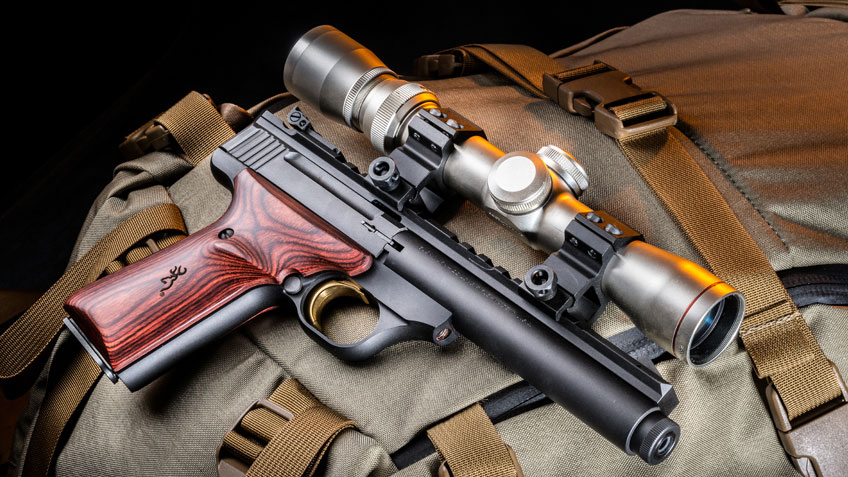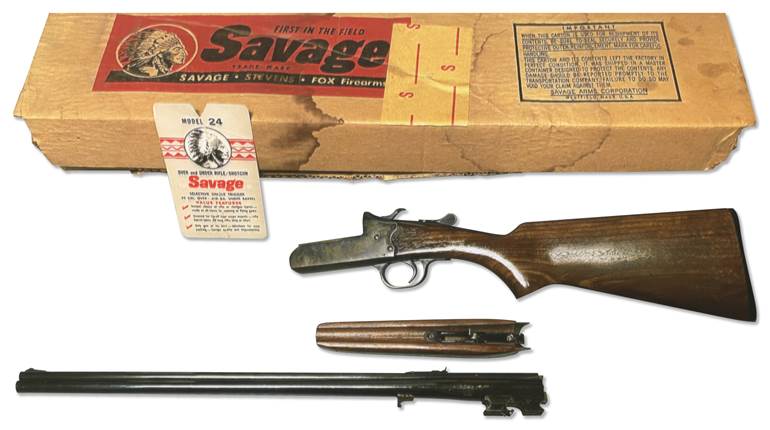
Browning introduced the Buck Mark .22 Long Rifle pistol line in 1985, replacing the company’s Challenger Series pistols. Engineered to provide sportsmen with an accurate and dependable rimfire pistol, the Buck Mark line was also designed to be affordable. Browning currently offers more than 20 variations of the Buck Mark with different barrel lengths, finishes and stocks. The subject of this review is one of Browning’s newest iterations of the Buck Mark: the Field Target Suppressor Ready.
This particular model features an all-steel, 5½", heavy-profile barrel measuring 0.90" in diameter. The muzzle end of the barrel is reduced to 0.50" and threaded 1/2x28 TPI for the potential use of a suppressor or a similarly threaded muzzle device, and a steel thread protector is included. For accuracy’s sake, each Buck Mark chamber is hand-reamed. The Buck Mark receivers are all CNC-machined from 7075-T6 aircraft-grade aluminum, and are anodized a matte black to match the non-reflective bluing of their slides and barrels.
Browning outfits the Buck Mark with its Pro-Target rear sight, which offers 16 clicks of adjustment per revolution compared to the industry standard of 12, giving shooters every edge in precisely zeroing their pistols. On this Field Target model, a Patridge-style front sight is used. The sights are not slide-mounted, so they do not move when the slide cycles, and an integral Picatinny rail runs from the front sight to the rear sight giving the shooter the ability to mount a scope, red-dot or reflex optic.

Controls of the Buck Mark are conveniently located for right-hand shooters, and can be manipulated by the shooter’s thumb while maintaining a firing grip. There’s a slide lock and a manual safety, the latter of which blocks the sear when engaged in its up position. The magazine release is located in an M1911-inspired location. Depressing it will eject the 10-round magazine forcibly, as a spring-loaded magazine ejector exerts pressure on the magazine’s floorplate. Browning uses a magazine safety on the Buck Mark, and, as a result, the pistol will not fire without the magazine in place. Browning cautions against dry-firing the gun; since the firing pin impacts the rim of the cartridge, dry-firing can cause peening on the chamber end of the barrel as well as undue stress on the firing pin.
Our test gun’s trigger broke crisply at 3 lbs., 12 ozs., of pressure with very little overtravel. The pivoting trigger is wide and curved, which our evaluators found to be comfortable for precision shooting. Browning has added a splash of color to the Field Target Suppressor Ready by gold plating the trigger and adorning the frame with red cocobolo stocks.
It didn’t take long to get the rear Pro-Target sight zeroed for 25-yd. shooting. Most of our groups using the iron sights at this distance measured around 1", but in an effort to find the gun’s true accuracy potential we mounted a Simmons 2.5-7X pistol scope and fired groups with three different ammunition loads with the scope’s magnification set on 5X. Shooting from a DOA Tactical portable bench and using a Millett BenchMaster for support, we fired five, five-shot groups with each type of ammunition.
Remington/Eley’s Match EPS load produced both the smallest individual group and the tightest five-group average, at 0.56" and 0.60", respectively. However, the average for all 15 groups measured only 0.66", which is remarkable accuracy for a production rimfire pistol at this range. The heavy-profile steel barrel gives the Field Target Suppressor Ready a good degree of heft, weighing in at 38 ozs. The crosshairs never moved off the target, and we were able to watch our rounds impact the paper.
During our 300-round evaluation, there were six failures to eject, with at least one from every load tested. There were also three failures to detonate—a fairly common problem with rimfire ammunition. Rimfire guns are notoriously picky about ammunition, and it would serve the shooter well to buy a variety of loads and test each for reliability and performance.

The manual advises users to clean their barrels from the muzzle end using a properly fitted bore brush and then patches. It is our recommendation to leave the thread protector in place during this operation in order to protect the crown of the barrel. The chamber end of the barrel and breechface of the slide should be lightly scrubbed with a brush saturated with a quality solvent. The magazine feed lips and follower should also be scrubbed until clean, and the outside of the magazine body should be wiped down.
Overall, we were very impressed with the fit and finish of our test Buck Mark Field Target Suppressor Ready. It possesses an ideal grip angle, and its stock panels are contoured for a comfortable firing grip. The gun also has remarkable inherent accuracy. Combined with its ability to accept a suppressor and a multitude of different optics, the model offers sportsmen a great deal of versatility for their rimfire handgun needs.







































